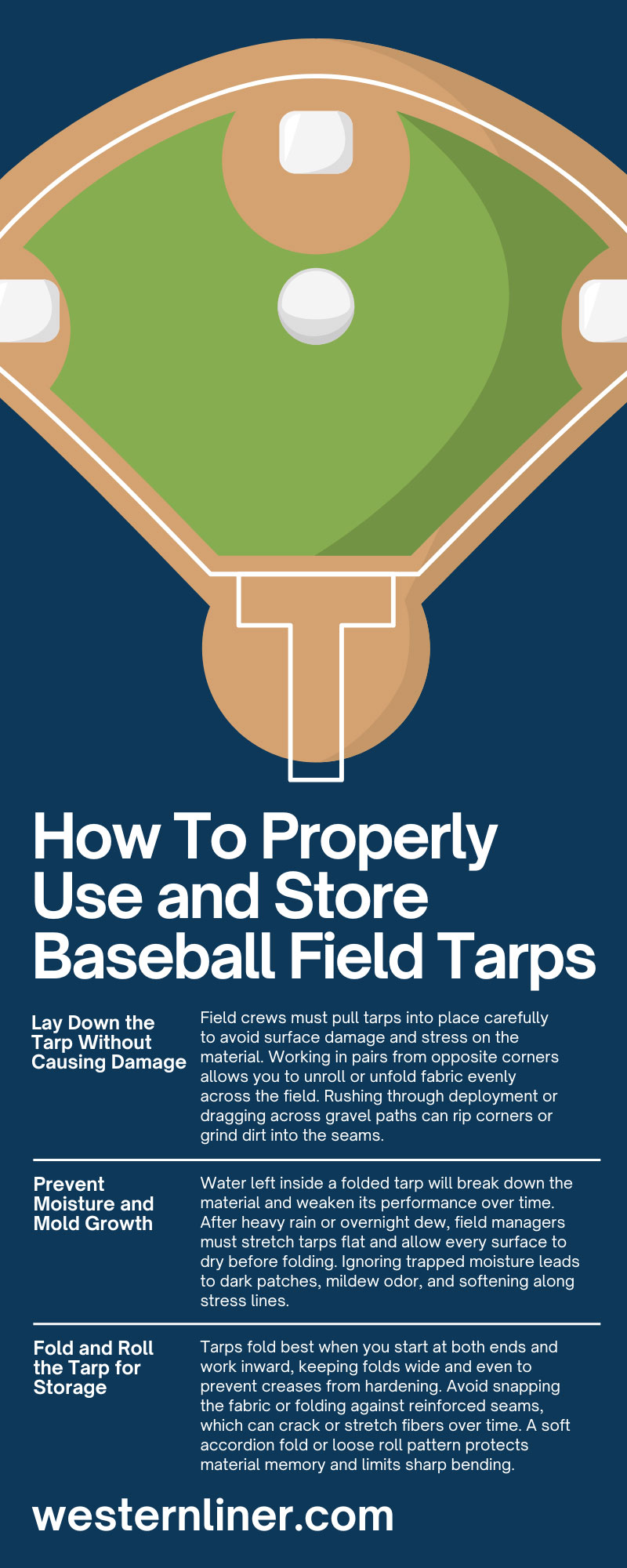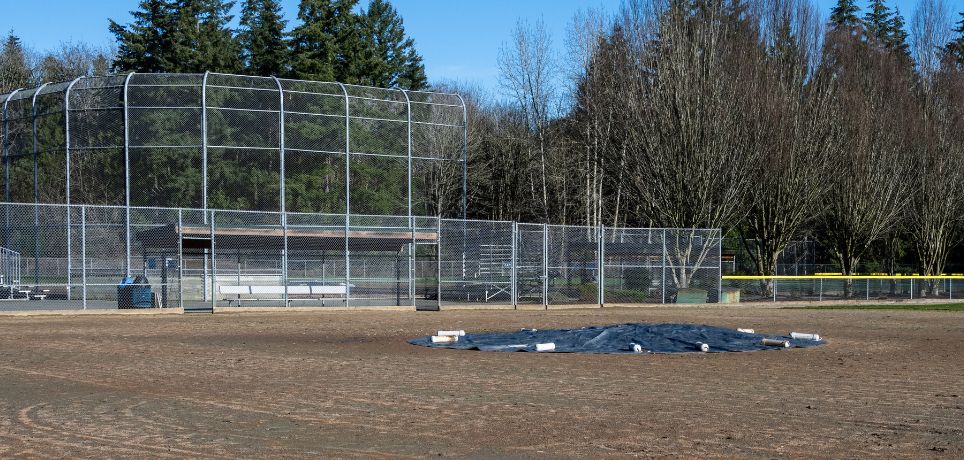Baseball field covers play a vital role in keeping your playing surface dry, safe, and game-ready, especially during unpredictable weather. Field managers often handle heavy-duty tarps in challenging conditions, and a single mistake during placement or storage can lead to early material breakdown. Whether you manage a high school facility, a city field, or a commercial sports complex, you need to take proper steps when using and storing tarps.
Small details like how you fold corners or where you store rolled material can change a tarp’s lifespan by years. Investing the time in good tarp management habits will pay off with better safety, faster field prep, and fewer equipment replacements.
Choose the Right Size and Material for the Field
You need a tarp that fits your field’s unique layout without dragging into dugout areas or overlapping fence lines. Standard sizes exist, but measuring your base-to-base layout and foul territory helps you match the tarp’s footprint precisely. A tarp that fits correctly protects your infield while reducing unnecessary friction or stress at the seams.
Field teams benefit from lightweight materials that provide strength without creating labor strain. Reinforced vinyl or polyethylene with ripstop technology stands up to repeated use on both grass and clay surfaces. Field crews can fold or roll reinforced fabrics with less effort than thicker, outdated tarp materials.
Prefabricated covers offer another major advantage by arriving in large sheets without heavy seams or stitched panels. Eliminating patchwork fabrication reduces tear points and makes installation faster for short-staffed crews. Some manufacturers design wind-weighted edges or integrated grommets to help field managers keep tarps in place without hauling extra sandbags.
Lay Down the Tarp Without Causing Damage
Field crews must pull tarps into place carefully to avoid surface damage and stress on the material. Working in pairs from opposite corners allows you to unroll or unfold fabric evenly across the field. Rushing through deployment or dragging across gravel paths can rip corners or grind dirt into the seams.
Some crews transport tarps by hand or over their shoulder, which causes unwanted folds and pressure points. You should move field covers using turf-safe carts or rollers designed to protect the tarp from sharp contact and excessive bending. If no roller exists on site, storing tarps on a padded dolly or tarp drum gives the same protective benefit.
To use and store baseball field tarps effectively, you must treat the fabric like a performance tool, not just a giant sheet of plastic. Avoid kicking, throwing, or piling tarp sections on fences or benches between uses. Respect for the tarp during every step of use sets the tone for its longevity and function across seasons.
Prevent Moisture and Mold Growth
Water left inside a folded tarp will break down the material and weaken its performance over time. After heavy rain or overnight dew, field managers must stretch tarps flat and allow every surface to dry before folding. Ignoring trapped moisture leads to dark patches, mildew odor, and softening along stress lines.
Storage containers matter just as much as drying methods. You should store tarps in breathable units like mesh bins or open-faced racks that allow air to circulate between folds. Airtight tubs or plastic-wrapped piles trap humidity and speed up fiber breakdown even during short off-season breaks.
Humidity-prone regions like coastal cities or warm southern climates require even more routine inspections. At least once per month, unwrap and check your tarp for early signs of black mold or damp residue hiding in deep folds. Catching problems early reduces the chance of field damage during an unexpected downpour.
Fold and Roll the Tarp for Storage
Tarps fold best when you start at both ends and work inward, keeping folds wide and even to prevent creases from hardening. Avoid snapping the fabric or folding against reinforced seams, which can crack or stretch fibers over time. A soft accordion fold or loose roll pattern protects material memory and limits sharp bending.
Field managers should roll tarps when possible, especially if the field allows upright storage on a drum or spindle. Rolling keeps dirt away from fabric interiors and avoids pressure layering that weakens flat folds. A rolled tarp also takes up less square footage inside a shed or equipment trailer.
To use and store baseball field tarps properly, label every tarp clearly with its size, use location, and last application date. Labels prevent confusion during double-headers or emergency weather prep and help teams rotate older materials first. That level of organization reduces stress when you need to move fast under pressure.
Store Tarps in a Protected and Accessible Location
Storage location influences how often a tarp remains usable through the season. Field managers should install wall brackets or horizontal winches inside climate-controlled storage areas, away from direct sunlight or standing water. When interior space runs short, overhang racks beneath stadium seating or shade structures work as a secondary option.
Avoid leaving tarps in open-air sheds, even with plastic coverings or tarpaulin tents. Sunlight, temperature swings, and rodent exposure all contribute to tarp degradation during long-term outdoor storage. When you elevate your tarps off the ground, you also reduce contact with pests and debris while improving airflow.
We at Western Environmental Liner provide baseball field covers for field managers who need long-lasting protection that stores easily and performs reliably. Our large prefabricated sheets arrive ready for quick deployment and deliver high performance without the heavy weight or handling headaches. By choosing advanced materials and proper handling methods, you can count on your tarp to work game after game.
Extend Tarp Life With Routine Inspections and Repairs
Well-maintained tarps last significantly longer and require fewer full replacements. Field crews should inspect edges, seams, and anchor points at least once per month—more often during high-use seasons. Small issues like frayed loops, surface scuffs, or stitching shifts quickly become big problems without attention.
Repair kits built for vinyl or reinforced fabrics allow managers to patch small punctures before they stretch. Avoid duct tape or generic patches, which often peel after exposure to rain or sunlight. Applying a manufacturer-recommended patch preserves the material’s integrity and appearance without adding unnecessary weight.
Assign tarp inspection to a consistent crew rather than leaving the task to volunteers or rotating staff. Familiar eyes catch details more easily, and consistency builds accountability across your field operations. Proactive inspections prevent weather-day chaos and reduce field downtime between games or tournaments.
Protecting your field with the right tarp starts long before the weather hits and continues after the skies clear. Your decisions about material, placement, and storage shape how well your cover holds up under pressure.
Field managers who treat tarps as part of game-day equipment build smarter, safer, and more efficient prep systems. Reach out to Western Environmental Liner today to explore custom tarp options that match your field’s exact needs.



